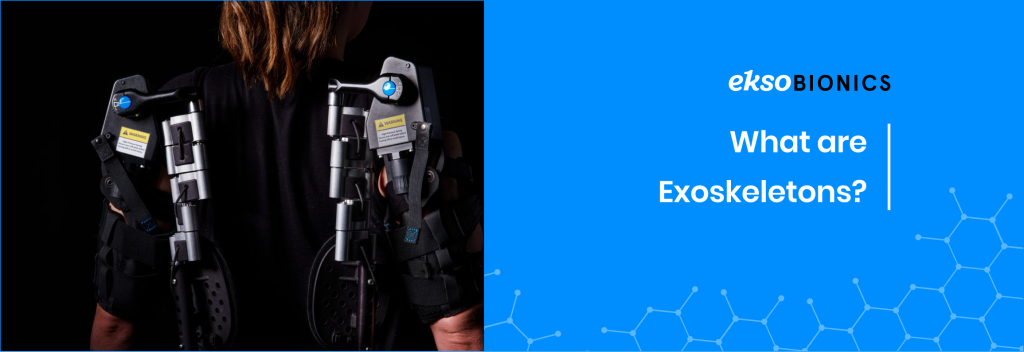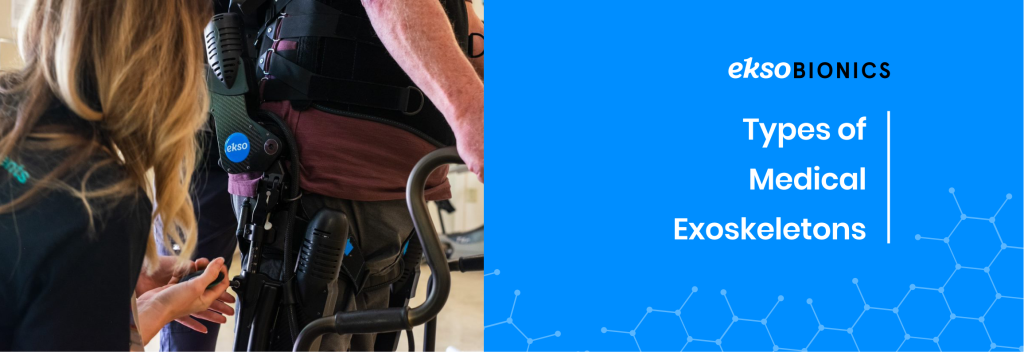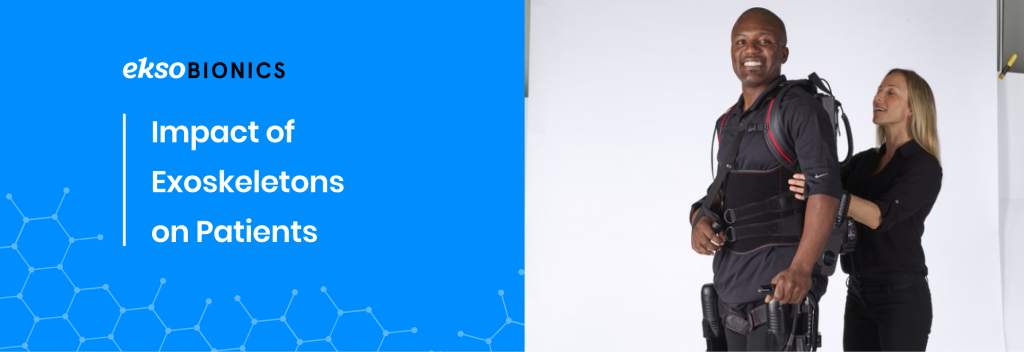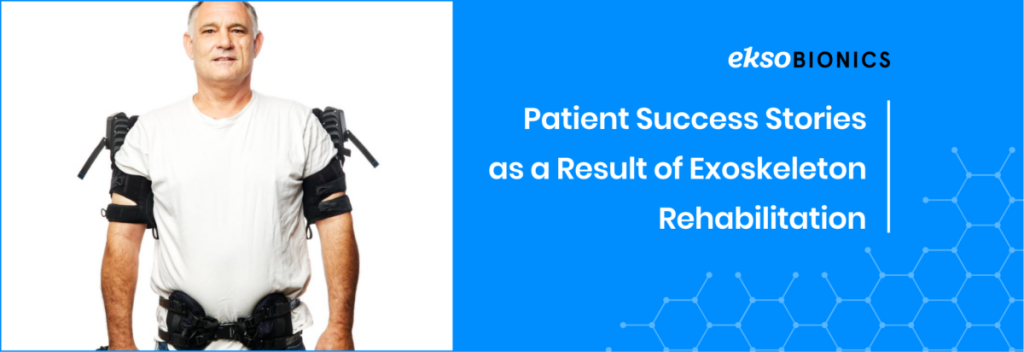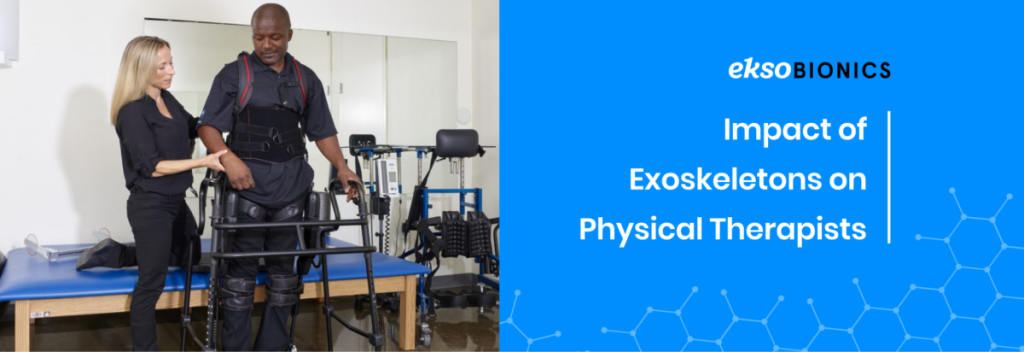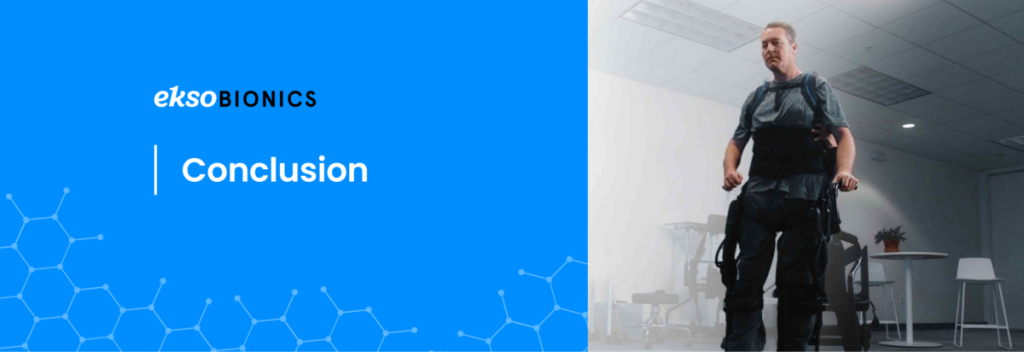Physical therapy has evolved so much over the last century. From the early 1900s, when it was used to treat injured soldiers, to today, where there is a myriad of emerging rehabilitation technologies. Exoskeleton rehabilitation in physical therapy is a rapidly evolving field that offers hope for people with disabilities or injuries who are seeking to regain mobility and independence. Exoskeletons augment or enhance the physical capabilities of the user and have the potential to transform the way we approach rehabilitation. But, how effective are exoskeletons in helping people recover from injuries or disabilities? In this article, we will explore the current state of research on exoskeleton rehabilitation in physical therapy and consider the potential benefits.
What is An Exoskeleton, and How do Exoskeletons Work?

An exoskeleton is a wearable technology that is designed to augment or enhance the physical capabilities of the user. It is typically a metallic/carbon suit that is worn on the outside of the body and provides additional support or strength to the wearer.
Exoskeletons were first developed by General Electric in the 1960s, with funding from the United States Department of Defense, as a way to enable humans to lift heavy objects. [1] In the 1980s, scientists began to explore the use of exoskeletons for military purposes, giving soldiers additional protection and abilities during warfare. [2] Today, exoskeletons are being used in rehabilitation to help people recovering from injuries to stand and walk. [3] They are also being used in other industries like agriculture, construction, and manufacturing to help with repetitive manual tasks and reduce fatigue and pain in the back, neck, and shoulders. [4]
Exoskeletons typically consist of a series of interconnected joints and motors that are powered by a battery or other power source. They may also include sensors and control systems that enable the user to control the exoskeleton and adjust its movements. Some exoskeletons also include features such as haptic feedback, which can provide the user with tactile sensations to enhance their sense of touch and proprioception.
There are several different types of exoskeletons, each designed for specific purposes and applications. Lower limb exoskeletons are designed to be worn on the legs and are used to assist with walking or to provide additional support and stability for people who have difficulty standing or walking on their own. Upper limb exoskeletons are designed to be worn on the arms and are used to assist with lifting or other upper body tasks.
Exoskeletons are categorized into the type of power source they use. Some exoskeletons are powered by electricity, either from a battery or from an external power source. Others are powered by hydraulics, using pressurized fluid to move the joints and motors. There are also exoskeletons that utilize other types of power sources, such as pneumatic or mechanical systems.
- Active Exoskeletons
An active exoskeleton is a type of exoskeleton that requires the user to provide some form of input or control in order to operate. Active exoskeletons typically use actuators to convert hydraulic, electrical, and air energy into mechanical energy that is used in movement. They also use sensors and control systems to enable the user to control the exoskeleton’s movements. Active exoskeletons may also include feedback systems, such as haptic feedback, to provide the user with information about the exoskeleton’s movements or the environment.
- Passive Exoskeletons
Passive exoskeletons, on the other hand, do not require the user to provide any input or control in order to operate. They normally use springs and dampers to store energy generated during movement, which is then reused during motion. Passive exoskeletons are designed to provide support and assistance to the user automatically, without requiring any specific actions from the user. Passive exoskeletons may be used to provide additional stability and support to the user.
Both active and passive exoskeletons have their own advantages and disadvantages, and the choice between them depends on the specific application and the needs of the user. Active exoskeletons tend to be more complex and expensive than passive exoskeletons, but they offer more precise and flexible control for the user. Passive exoskeletons are simpler and cheaper, but they offer less control and may not be as effective in some applications.
Use of Medical Exoskeletons in Healthcare

Medical exoskeletons are designed for use in rehabilitation settings and are designed to help people with lower extremity weakness regain mobility and independence. They work by providing support and assistance to the user’s muscles and joints, allowing them to perform movements that they may not be able to do on their own. They may be used to help people with spinal cord injuries, stroke, or other neurological conditions to walk again. At Ekso Bionics, we primarily design medical exoskeletons that help patients recovering from brain injuries, spinal cord injuries, stroke, and Multiple Sclerosis walk again.
Medical exoskeletons may be used in a variety of settings, including hospitals, rehabilitation centers, and the user’s home. They may be used in conjunction with other physical and occupational therapy strategies to help patients regain their strength and mobility.
There is a growing body of research showing the effectiveness of exoskeletons in medical rehabilitation. Studies show that exoskeletons can improve walking speed, balance, and endurance in patients recovering from different conditions.
Effectiveness of Medical Exoskeletons
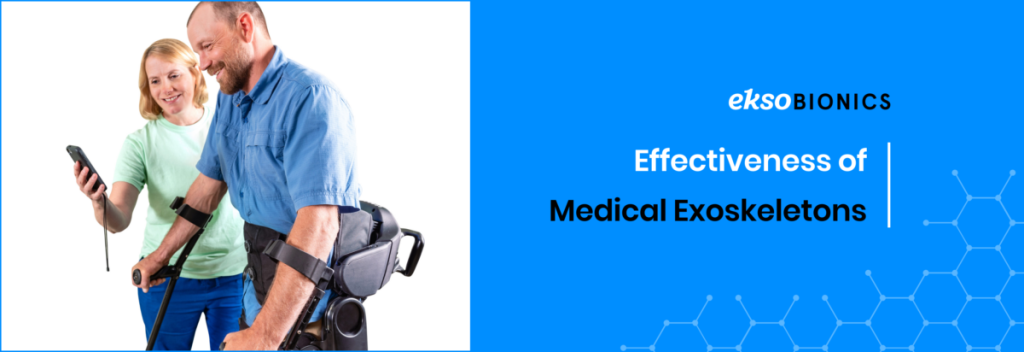
- Enables Ambulation
Patients recovering from injuries normally have a hard time walking without assistance. They typically need help from their physical therapist and assistive devices to move around. But with the use of exoskeletons, they can walk for longer periods of time to strengthen their muscles. In a 2021 study investigating the effect of robotic exoskeletons on ambulation, researchers reported that patients who trained using exoskeletons in addition to a conventional standard care treatment walked twice the distance (more number of steps) as patients who only received the standard care treatment. [5]
In a randomized control trial studying the effect of exoskeletons on non-ambulatory patients, researchers reported that patients who trained using an exoskeleton walked more steps than those who received usual care. “The Ekso group walked an average of 592 steps per session while the usual care group walked 330 steps.” [6]
- Improves Gait
Gait rehabilitation is one of the main focuses in physical therapy, and exoskeletons have demonstrated a lot of potential in improving gait. In a 2020 study investigating gait changes after exoskeleton training, researchers concluded that functional and neuromechanical improvements were achieved after four weeks of gait training. It goes on to say that “there could be potential long-term effects of improved loading and unloading, increased step length, and increased speed due to RE gait training.” [7]
- Improves Balance
Balance is an important consideration in rehabilitation as balance deficiencies hugely limit activities of daily living. While there aren’t a lot of studies in this area, the few studies that have been conducted show a positive correlation with the use of exoskeletons in balance training. In a 2019 study investigating the effects of an Ekso Bionics exoskeleton on balance, researchers reported that exoskeleton rehabilitation showed a significant impact on balance in patients recovering from a stroke. [8] In a recent 2021 study, researchers reported that exoskeletons improved balance in patients affected by Multiple Sclerosis. [9]
- Reduces Hospital Costs
Using exoskeletons in your rehabilitation center might help you manage your running costs. Following a budget impact analysis of exoskeletons, research shows that exoskeletons reduce locomotor training costs by $1,114 to $4,784 per year when used in 10% of annual locomotor training sessions. [10] These savings could be diverted to other departments or recouped back into the profits of the clinic.
- Improves Quality of Life
Exoskeletons can lead to an increased quality of life for patients recovering from different injuries. This was demonstrated in a 2022 study that investigated the effect of exoskeleton training on the quality of life after two months. The researchers of this study reported that the training helped with pain, bladder management, and increased quality of life. [11] The use of exoskeletons also results in psychological benefits as patients can engage with each other at eye-level contact. [12]
- Helps Attain Required Therapy Hours
In the US, patients in acute rehabilitation are required to get at least three hours of therapy five days every week. However, this is becoming increasingly difficult to meet due to the reduced availability of rehabilitation services. The pressure on the system is too much, but exoskeletons can help with this dilemma. Pam Lanter, PT, DPT, NCS, Manager of Rehabilitation Services at UH St. John says, “In just one session with the [exoskeleton], we’re able to accomplish what may have taken 5-10 sessions without it.” [13]
- Reduces the Burden of Therapy on Therapists
Exoskeletons are also useful for physical therapists too. They help reduce the risk of workplace injuries and exhaustion. This results in better service delivery since you can take care of patients without fatigue. This assertion was confirmed in a 2021 study investigating the efficacy of exoskeleton rehabilitation for spinal cord rehabilitation. [14]
- Improves Emotional Well-Being
Apart from physiological benefits, exoskeletons are also linked to psychological benefits. When Alex, who is recovering from a spinal cord injury he got while tobogganing, was asked about his exoskeleton rehabilitation sessions, he said, “It was amazing to be walking again. It really did a lot for my mental and emotional well-being, not to mention the huge health benefit of being vertical. I remember the first time standing up. This gave me something fun and exciting to look forward to every week in a time when I was dealing with a great deal of loss.” [15] Exoskeletons can give patients hope for the future and also increase their engagement and participation in rehabilitation. [16]
- Helps Reduce Injury-Related Complications
Patients can develop secondary complications from their injuries due to prolonged sitting. Because of their decreased ability to walk, patients are at risk of developing osteoporosis, bone fractures, pressure sores, and blood clots. Medical exoskeletons benefit these patients by enabling them to stand and move their legs when they otherwise could not, helping to decrease these risks. Dr. Chester Ho, associate professor in the University of Calgary Department of Clinical Neurosciences and member of the Hotchkiss Brain Institute says, “exoskeletons may potentially promote recovery and reduce complications in spinal cord injury (SCI) patients by reducing loss of bone and muscle mass caused by spending so much time lying down, and also improve breathing and bowel function.” [15]
Conclusion

Exoskeletons are still a relatively new technology, and more research is needed to fully understand their potential and to determine the best ways to use them in rehabilitation settings. However, their benefits are undeniable. If you are looking for great exoskeletons for your clinic, feel free to check out our FDA-approved EksoNR.
We combine clinical and engineering expertise to create innovative robotics for rehabilitation centers. Our exoskeletons can be used in therapy by patients who are recovering from stroke, brain injury, spinal cord injury, or Multiple Sclerosis to regain the ability to walk. Contact us today to learn more about our products.
References:
- Exoskeletons and robotic prosthetics: a review of recent developments | Emerald Insight https://www.emerald.com/insight/content/doi/10.1108/01439910910980141/full/html
- LIFESUIT Exoskeleton Gives the Gift of Walking so They Shall Walk | IEEE Conference Publication | IEEE Xplore https://ieeexplore.ieee.org/document/6970309
- WHEN WERE ACTIVE EXOSKELETONS ACTUALLY BORN? | International Journal of Humanoid Robotics https://www.worldscientific.com/doi/abs/10.1142/S0219843607001163
- Exoskeletons – a review of industrial applications | Emerald Insight https://www.emerald.com/insight/content/doi/10.1108/IR-05-2018-0109/full/html
- Robotic Exoskeleton Gait Training During Acute Stroke Inpatient Rehabilitation – PMC https://www.ncbi.nlm.nih.gov/pmc/articles/PMC7661791/
- Efficacy of an exoskeleton-based physical therapy program for non-ambulatory patients during subacute stroke rehabilitation: a randomized controlled trial https://jneuroengrehab.biomedcentral.com/articles/10.1186/s12984-021-00942-z
- Kinetic Gait Changes after Robotic Exoskeleton Training in Adolescents and Young Adults with Acquired Brain Injury – PMC https://www.ncbi.nlm.nih.gov/pmc/articles/PMC7641681/
- Effects of Exoskeleton Gait Training on Balance, Load Distribution, and Functional Status in Stroke: A Randomized Controlled Trial https://pubmed.ncbi.nlm.nih.gov/32010039/
- Can powered exoskeletons improve gait and balance in multiple sclerosis? A retrospective study https://pubmed.ncbi.nlm.nih.gov/33534272/
- Budget impact analysis of robotic exoskeleton use for locomotor training following spinal cord injury in four SCI Model Systems | Journal of NeuroEngineering and Rehabilitation https://jneuroengrehab.biomedcentral.com/articles/10.1186/s12984-019-0639-0
- Full article: Improvement of quality of life after 2-month exoskeleton training in patients with chronic spinal cord injury https://www.tandfonline.com/doi/full/10.1080/10790268.2022.2052502
- Users with spinal cord injury experience of robotic Locomotor exoskeletons: a qualitative study of the benefits, limitations, and recommendations – PMC https://www.ncbi.nlm.nih.gov/pmc/articles/PMC7488437/
- Exoskeleton Enables and Enhances Movement in Physical Therapy Patients | University Hospitals https://www.uhhospitals.org/for-clinicians/articles-and-news/articles/2020/11/exoskeleton-enables-and-enhances-movement-in-physical-therapy-patients
- Evaluating the Utilization and Efficiency of Wearable Exoskeletons for Spinal Cord Injury Rehabilitation | Shirley Ryan AbilityLab https://www.sralab.org/research/labs/cror/projects/evaluating-utilization-and-efficiency-wearable-exoskeletons-spinal-cord-injury-rehabilitation
- Spinal cord injury patients may benefit from using exoskeleton earlier in treatment | News | University of Calgary https://ucalgary.ca/news/spinal-cord-injury-patients-may-benefit-using-exoskeleton-earlier-treatment
- Efficacy of Overground Robotic Gait Training on Balance in Stroke Survivors: A Systematic Review and Meta-Analysis – PMC https://www.ncbi.nlm.nih.gov/pmc/articles/PMC9221355/


